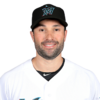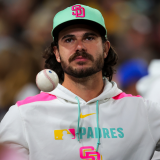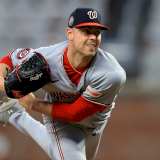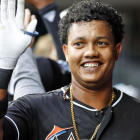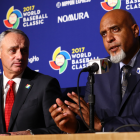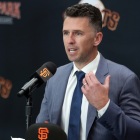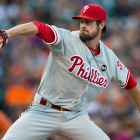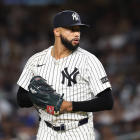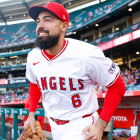With J.T. Realmuto gone, who will be the next Marlins player dealt? Ranking Miami's remaining trade chips
With Realmuto gone, the Marlins are running out of desirable parts
On Thursday, the Miami Marlins traded catcher J.T. Realmuto to the Philadelphia Phillies in exchange for international bonus pool money and three players: catcher Jorge Alfaro and pitching prospects Sixto Sanchez and Will Stewart.
Realmuto is the latest in a long line of good Marlins played to be traded elsewhere. As Sam Miller noted, the Fish have now dealt 23 of the top 25 players in franchise history. They've made a habit of trading their best through management and ownership changes. Lately, they've just made a habit of trading. Consider that this was the Marlins' most-used lineup in 2017 ...
- Dee Gordon
- Giancarlo Stanton
- Christian Yelich
- Marcell Ozuna
- J.T. Realmuto
- Derek Dietrich
- Tomas Telis
- Miguel Rojas
… and that of those eight position players, only Rojas still remains in the organization. Since then, the Marlins have stripped their roster of its most desirable parts.
This being the Marlins, however, there's always another deal right around the corner. With that in mind, we put together a buyer's guide for what remains of the Marlins roster -- a preview of who they might deal next, essentially. The nine players listed below are presented in order of perceived likelihood. Keep in mind this is more art than science, and more guesswork than art.
We're starting with Neil Walker, who hasn't officially suited up for the Fish yet. He recently signed a one-year deal worth $2 million to serve as Miami's most-days first baseman. At minimum, Walker should receive ample playing time to prove last season's 79 OPS+ was a fluke. Should he perform closer to his career mark (111 OPS+), he'll find himself on the move before the deadline. Do note that Walker's numbers may hinge on how Don Mattingly uses him -- Walker is a much better hitter against right-handed pitchers and ought to be platooned with Peter O'Brien.
Curtis Granderson is another veteran platoon bat who hasn't appeared in a game yet since signing with the Marlins. He slots in second instead of first because his agreement with Miami is of the minor-league variety. Provided Granderson makes the club and hits like he did last season (115 OPS+), he should be moved in an August trade for the third consecutive year.
No one tracks these kinds of things, but Dan Straily might've been mentioned in more trade rumors than any Marlin other than Realmuto the past two seasons. If so, that honor has more to do with the Marlins' place on the win curve rather than his value. Not that Straily is without his merits. He's managed a 99 ERA+ over the last three seasons. But he's prone to injury and home run alike, and his low-90s velocity stands out as a red flag in this day and age. Straily has two more seasons of team control remaining. Don't expect him to finish those out with the Fish.
We're lumping together Adam Conley and Drew Steckenrider -- not to save space, but because they're similar in a few senses. Both are older than expected and coming off disappointing seasons. Yet their live arms and oodles of team control figure to make them appealing targets for contenders seeking a bargain. There's a real chance Conley and/or Steckenrider ends up getting moved in a Kyle Barraclough-like deal within the next year.
This may surprise folks who don't pay close attention to the Marlins, but Jose Urena will have two years of team control remaining after this season. He's been around long enough to toss nearly 500 big-league innings, and along the way has shown he's a tolerable starting option. Miscast as a staff ace, Urena is never going to be as productive as his mid-90s heat suggests. Nonetheless, he made an interesting alteration last season, adapting his sinker as his primary fastball. The switch led to more whiffs and more grounders, which is usually a good formula -- and one that could position him for his best season yet come 2019. If so, Urena could find himself as a contender's No. 4 starter by year's end.
You have to feel a little bad for Starlin Castro. He finished last season with almost the exact OPS+ he had in his All-Star 2017 and nobody noticed. He upped his walk rate and nobody noticed. He remained a serviceable starting second baseman and nobody noticed. Presumably the reason nobody noticed is teams don't want to pay an average second baseman what Castro is making -- or roughly $12 million this season, including a buyout on his club option for 2020. Maybe the Marlins will opt to eat some of that to trade Castro in July.
Martin Prado is entering the final year of a three-year pact with the Marlins that heretofore has seen him appear in 91 games and hit for a 71 OPS+. Yikes. Prado used to be an unheralded player who could slot in across the diamond. Now, he's viewed as little more than a $15 million sunk cost. The odds of Prado remaining healthy and productive enough for anyone to trade for him seem slim. But here's hoping for his sake he can end his contract on a high note.
Wei-Yin Chen threw the most innings of his Marlins career last season, with 133. That's not what the Fish had in mind when they signed him to a five-year deal worth $80 million prior to the 2016 season. The backloaded nature of the deal means Chen will bank some $42 million over the next two seasons, with an innings-based conditional player option for 2021. Chen at his best is a finesse lefty with good contact-management skills. His ball-tracking data suggests he was better than his ERA last season, meaning he could be in for a better 2019. Heck, though, if teams aren't willing to pay Dallas Keuchel, then why would they trade for Chen? (Spoiler: they won't.)


